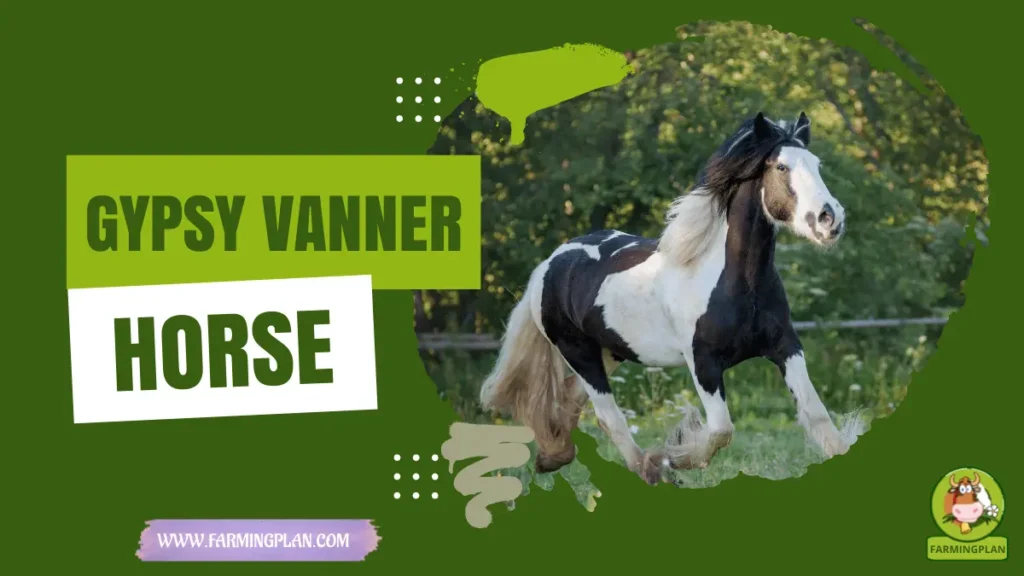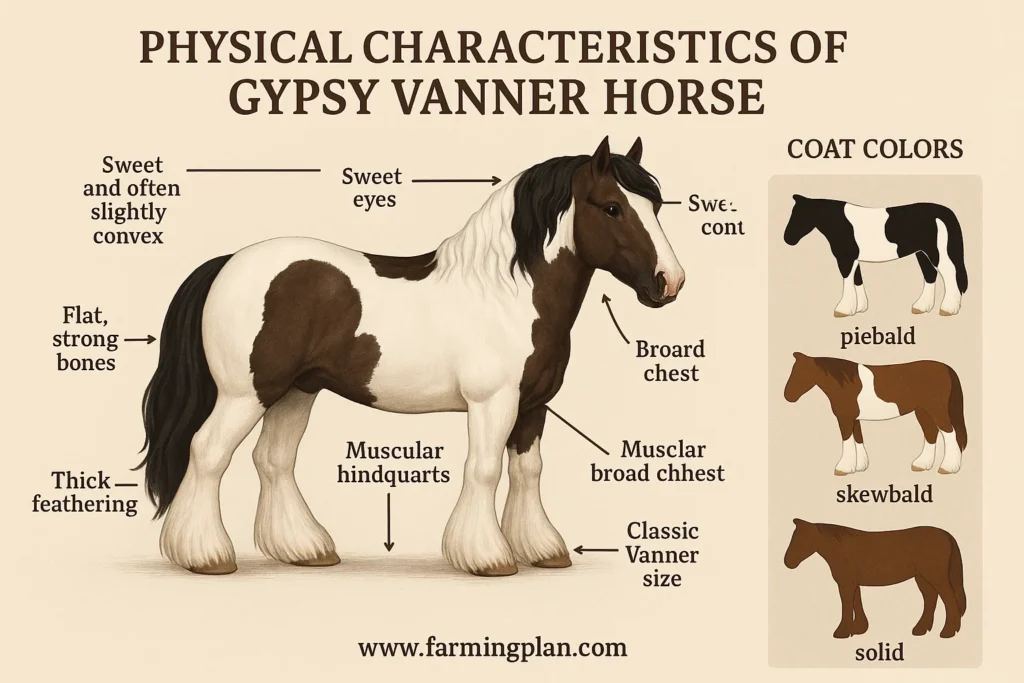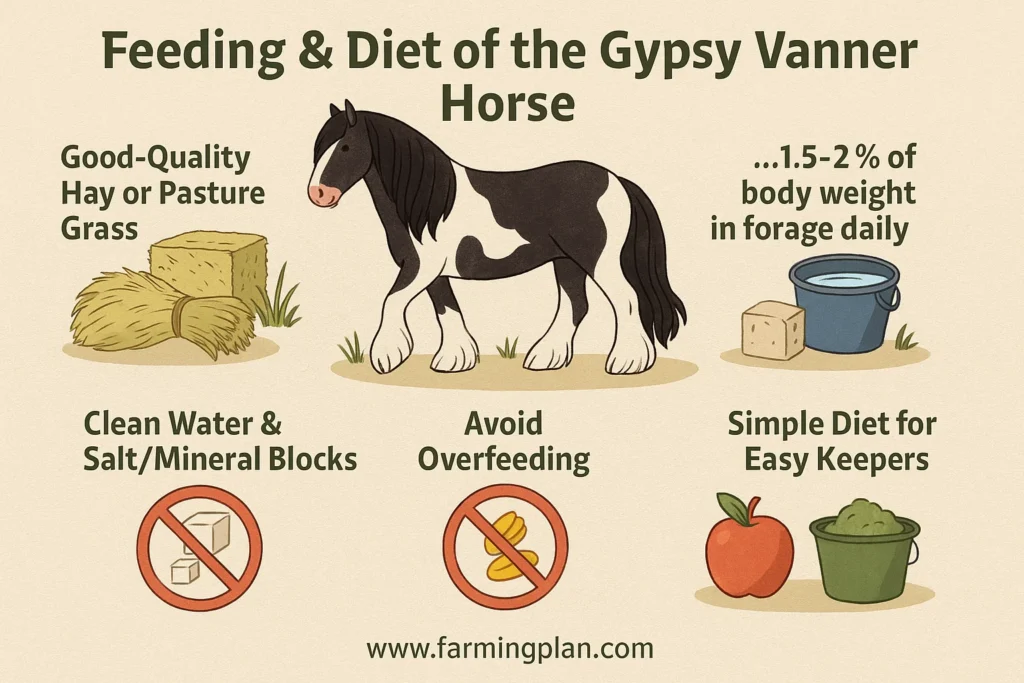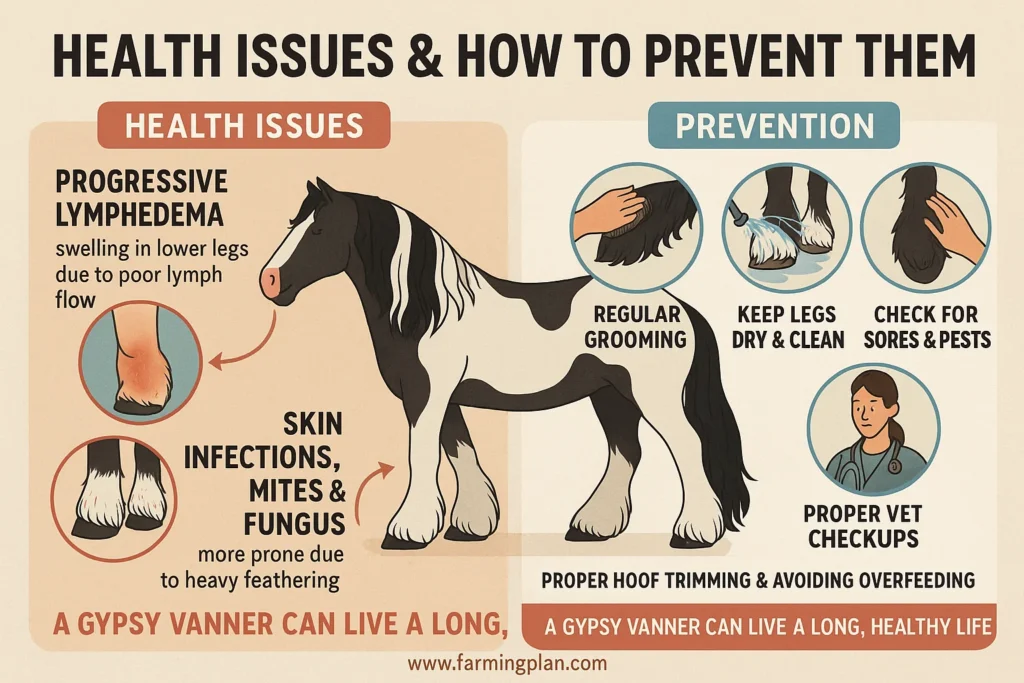The Gypsy Vanner Horse is more than just a beautiful animal—it’s a loving, gentle companion perfect for families, first-time horse owners, and hobby riders. With its long flowing feathers, bold color patterns, and calm temperament, this horse turns heads wherever it goes. Originally bred by the Romani people to pull covered wagons, the Gypsy Vanner brings a special mix of power and grace. In this article, we’ll explore everything about this remarkable breed—from its history and personality to health care and where you can find one. Whether you’re dreaming of owning one or just curious, you’ll walk away with all the details you need about this incredible horse.

History & Origin of Gypsy Vanner Horse
The Gypsy Vanner Horse story begins in the British Isles with the Romani, or Gypsy, people who needed a strong, gentle, and flashy horse to pull their wagons across the countryside. They selectively bred sturdy draft horses like Shires and Clydesdales with smaller ponies and colorful horses to create a new type of horse—one that could carry loads, look beautiful, and have a calm nature. Over time, this special breed became known as the Gypsy Vanner, also referred to as the Gypsy Horse, Gypsy Cob, or Vanner Cob.
The name “Gypsy Vanner” was introduced in the 1990s when American breeders Dennis and Cindy Thompson discovered the breed while traveling in England. Impressed by its beauty and gentle personality, they imported the first Gypsy Vanner Horse to the U.S. and helped form the Gypsy Vanner Horse Society. This marked the breed’s formal introduction to North America. Today, breed registries like the Gypsy Horse Registry of America and others preserve the original Romani breeding goals: a strong, colorful, people-sized draft horse.
Physical Characteristics of Gypsy Vanner Horse
Gypsy Vanner horses stand out because of their thick feathering around the legs, strong builds, and eye-catching coat colors. Most commonly, they have piebald (black and white) or skewbald (brown and white) patterns, but they can also come in solid colors and rare, exotic combinations. Their heads are sweet and often slightly convex, with wide foreheads and gentle eyes. These horses have flat, strong bones and a short back, making them look powerful and compact.

Size-wise, the breed is generally divided into three groups: Classic Vanners (14-15 hands high), Mini Cobs, and larger Drum Horses (crossed with bigger draft breeds). Their broad chests and muscular hindquarters give them the strength to pull loads while still being comfortable for riding. The flowing mane and tail add to their elegant look. Whether you’re into shows or simple trail riding, the Gypsy Vanner’s beauty never goes unnoticed.
Temperament of the Gypsy Vanner Horse
One of the best things about Gypsy Vanners is their personality. These horses are known for being calm, gentle, and willing to please. They’re very social and enjoy human interaction, making them a great choice for first-time horse owners and families with children. Even people who feel nervous around horses often find comfort in the Gypsy Vanner Horse steady presence.
These horses learn quickly, are not easily spooked, and rarely show aggression. They enjoy being groomed, ridden, and talked to. Their loving nature also makes them suitable for therapy work or as a companion animal. If you’re searching for a family-friendly breed with a kind heart and a level head, the Gypsy Vanner Horse fits that role perfectly.
Feeding & Diet of the Gypsy Vanner Horse
Feeding a Gypsy Vanner Horse starts with good-quality hay or pasture grass. They don’t need fancy feeds or large amounts of grain unless they are in heavy work or breeding. On average, a healthy adult will eat about 1.5-2% of its body weight in forage each day. Clean, fresh water should always be available, and you should also provide salt or mineral blocks to support their dietary needs.

While these horses are not particularly “hard keepers,” it’s important not to overfeed them. Their slower metabolism means they can gain weight easily, leading to potential health issues. Avoid sugary treats and rich grains unless advised by a vet. If your Vanner is a companion animal or ridden lightly, a simple diet keeps them healthy and economical to maintain.
Uses & Purposes of Gypsy Vanner Horses
Gypsy Vanner Horse are incredibly versatile. Their original purpose was to pull covered wagons or “bow-tops” for the Romani people, which means they’re naturally strong, balanced, and steady. Today, people use them for light farm work, pleasure riding, and driving carriages. Thanks to their kind nature and colorful looks, they often shine in horse shows and exhibitions. Many families also keep them as pets or therapy horses because of their easygoing personality. Whether you’re into western riding, trail rides, or competitive driving classes, a Gypsy Vanner Horse will meet your needs. With their flashy presence and calm behavior, they are excellent horses suitable for nearly every kind of horse lover.
Read more: Haflinger Horse: The Unbeatable Combination of Beauty and Strength
Special Features That Make the Breed Stand Out
The most noticeable feature of a Gypsy Vanner is its feathering—the long, silky hair around the lower legs. This gives them a majestic look when walking or running. The breed is also known for its broad body, sweet head, and unique coat colors, making every horse one-of-a-kind. Even their movement is smooth and floating, which is rare in draught horse types. Another standout feature is their size. Often called a “people-sized” draft horse, Gypsy Vanners are strong like larger breeds but shorter and easier to handle. Their calm temperament, eye-catching looks, and strong build make them perfect for shows, work, or riding. They’re a true blend of beauty, power, and kindness.
Health Issues & How to Prevent Them
Although generally healthy, Gypsy Vanner Horse can face certain health challenges. One common issue is progressive lymphedema, a swelling in the lower legs caused by poor lymph flow. This condition worsens without treatment, so early care is important. Because of their heavy feathering, they are also more prone to skin infections, mites, and fungus in moist environments.

Regular grooming helps prevent these issues. Keeping their legs dry and clean, checking for sores or pests, and scheduling routine vet checkups are all must-dos. Proper hoof trimming and avoiding overfeeding also help prevent joint stress and weight-related problems. With good care, a Gypsy Vanner Horse live a long, happy, and healthy life.
Read more: Suffolk Punch Horse: The Rare Breed You Can’t Afford to Miss
Step-by-Step Pet Owner Care Guide for Gypsy Vanners
Caring for a Gypsy Vanner is a rewarding experience, especially when you know exactly what they need. These gentle horses thrive on attention, cleanliness, and a simple but consistent care routine. Whether you’re welcoming your first Gypsy Vanner or want to improve your current care system, this five-step guide covers the essential areas of day-to-day management.
Step 1: Create a Safe, Comfortable Living Space
Start by giving your Gypsy Vanner a cozy, well-maintained home. These horses do best with access to both shelter and open space. A sturdy, dry stall is essential for rest and protection from rain, wind, or extreme temperatures. Bedding should be clean and changed regularly to prevent hoof issues or skin infections. Outside, provide a fenced pasture with soft footing and no sharp edges or toxic plants. Because they are social by nature, consider keeping them near other horses or animals for companionship. If pasture isn’t available year-round, allow turnout in a paddock for daily exercise and fresh air. Remember, their beautiful feathered legs can trap mud and moisture, so avoid overly wet or dirty turnout areas whenever possible.
Step 2: Groom Daily and Mind the Feathers
Gypsy Vanners are famous for their long, flowing manes, tails, and leg feathers, but this beauty needs regular maintenance. A quick daily grooming session goes a long way. Start by brushing the coat with a soft curry or dandy brush to remove dust and debris. Carefully detangle the mane and tail using a wide-toothed comb or your fingers to avoid breakage. The feathers require extra attention. Moisture and mud trapped in the leg hair can cause skin conditions like mites or scratches (pastern dermatitis). Gently wash and dry the legs as needed, and check for signs of irritation, heat, or scabs. Keeping the feathers trimmed slightly or braided can help manage upkeep, especially during wet months.
Step 3: Feed a Balanced, No-Fuss Diet
These horses thrive on simplicity. The base of their diet should be good-quality hay or pasture grass. In most cases, Gypsy Vanners don’t require heavy grain feed unless they’re in active training, growing, or breeding. Overfeeding grains can lead to obesity or digestive problems. Provide access to a salt block or mineral lick to help meet their nutritional needs. Make sure they always have fresh, clean water, especially during warm months or after exercise. Keep a regular feeding schedule and watch their body condition—adjust portions if they’re gaining or losing too much weight. Slow feeders or hay nets can help prevent overeating and keep them occupied longer.
Step 4: Stick to a Regular Health Routine
A healthy Gypsy Vanner is a happy one, and consistency is key. Schedule a farrier visit every 6–8 weeks to trim hooves and check for signs of thrush or cracks. Because their large feathering can hide issues, be sure to lift and inspect their feet during each grooming session. Teeth should be checked by an equine dentist at least once a year, as uneven wear can lead to eating problems or discomfort. Regular deworming and vaccinations are also essential—your vet can help you build a personalized care schedule. Pay close attention to skin, coat, and leg health. Early treatment of any swelling or irritation helps avoid larger problems later.
Step 5: Provide Daily Exercise and Mental Stimulation
Even though Gypsy Vanners are calm by nature, they still need movement and mental engagement. Daily turnout, light riding, or groundwork exercises keep them physically fit and mentally content. These horses enjoy routines and positive interaction, so include training games, obstacle courses, or short trail rides as part of their weekly schedule. Because they are highly trainable and enjoy human connection, many Vanners do well with liberty work or light driving. Mixing up activities helps prevent boredom and keeps your horse responsive and happy. Don’t forget: consistent handling builds trust and deepens the bond between you and your horse.
Read more: The Majestic Shire Horse: A Gentle Giant with a Rich History
Expert Tips & Best Practices for Gypsy Vanner Lovers
- Look for registered horses from known breeders to ensure quality and good health.
- Get your horse used to grooming early—especially feather care.
- Training works best with a gentle approach and regular routines.
- Keep your horse’s living space clean and dry to prevent leg swelling or skin issues.
A Groomed Gypsy Vanner Is A Happy Horse—Give Them Daily Care, And They’ll Give You A Lifetime Of Loyalty.
Where to Buy Gypsy Vanner Horses & What to Expect
You can find Gypsy Vanner Horses for sale through breeders, horse shows, or online directories. Searching gypsy vanner horses near me can lead to local farms and rescues. Always check the horse’s papers if you want a purebred. Ask about health records, temperament, and past training. Gypsy Vanner horses price can vary. A registered, trained horse might cost $10,000 to $25,000. Younger or untrained horses may be more affordable. Buying from rescues is cheaper but may come with extra care needs. Look for breeders who follow standards set by groups like the Gypsy Vanner Horse Society or Gypsy Horse Registry of America.
FAQ
How much does a Gypsy Vanner Horse cost?
Prices range from $10,000 to $25,000 depending on age, training, and bloodlines. Rescues may be cheaper.
Are Gypsy Vanners good for beginners?
Yes, their calm nature and trainability make them great for first-time horse owners and families.
Do Gypsy Vanners need a lot of grooming?
Yes, especially their leg feathers. Daily grooming keeps them clean and helps prevent skin issues.
Can I keep a Gypsy Vanner as a pet?
Absolutely. Many people keep them as companion animals due to their loving and social personality.
Where can I find a Gypsy Vanner near me?
Search online directories, breeder listings, or visit local farms. Always visit the horse before buying.
Conclusion
The Gypsy Vanner Horse is a rare blend of charm, strength, and gentleness. With its rich history, stunning looks, and easygoing nature, it’s the ideal choice for families, hobbyists, and horse lovers alike. By understanding their needs and caring for them properly, you can enjoy a lasting bond with one of the most magical horse breeds in the world.
